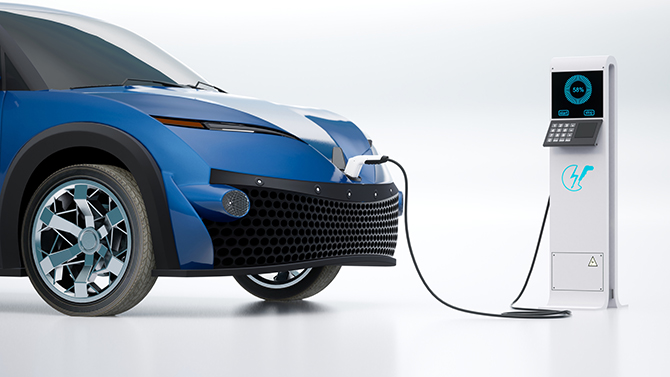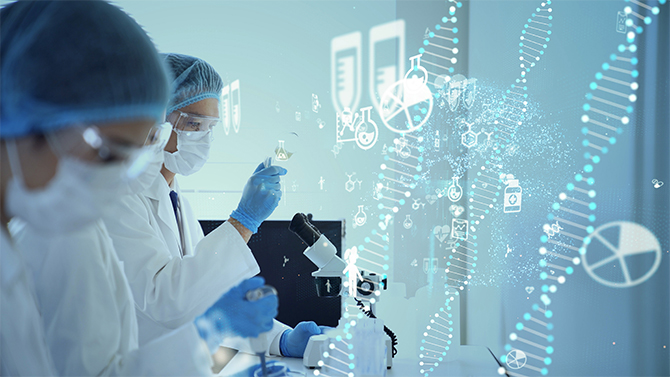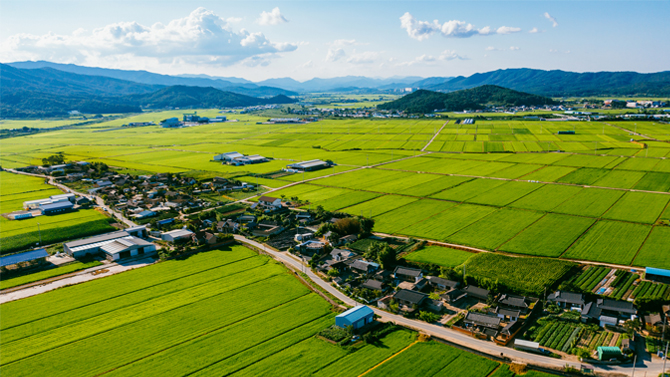Social Issues addressed by Sumitomo —Compass for the Future—
Remote inspection system eliminates time spent traveling to and waiting at construction sites, leading to higher productivity and workstyle reform
 New workstyles
New workstyles  Wellness
WellnessConstruction sites for infrastructure are often located in areas that are difficult to access, such as in mountainous terrain, and far from the offices where the people managing the projects are based. Moreover, a large-scale construction project may be dispersed among several sites and these sites may be at considerable distances from one another. Conventionally, witness inspections are conducted in the presence of the order placing party to confirm that construction has been done in accordance with the drawings, and so representatives of the order placing party have to travel to the construction site and representatives of the order receiving party have to receive them at the site and attend to them. In the case of a bridge project or an expressway refurbishment project involving construction at several locations simultaneously, travelling between these locations can be time consuming.
Telepresence refers to a suite of technologies enabling witness inspections from remote locations by utilizing networks and cameras to eliminate the traveling and waiting time associated with conventional inspections, thereby enhancing operational efficiency of both the order placing and order receiving parties. The Ministry of Land, Infrastructure, Transport and Tourism announced the procedures for telepresence in May 2020 and various companies have incorporated the approach in their business operations.
Sumitomo Mitsui Construction (SMCC) has developed “ENKEN™”, an inspection system that efficiently supports telepresence. SMCC applied this system for the first time at scale for remote inspection in a deck replacement project for the Matsukawa Bridge in Niigata Prefecture on the Kan-Etsu Expressway of East Nippon Expressway Company (NEXCO East).
“ENKEN” is an app for iPad. It allows sharing of video and audio as well as documents (in the PDF format) necessary for witness inspection, such as drawings and project management ledgers. Both the order placing party and the order receiving party can show documents and fill them in. When the witness inspection items are registered in advance, the parties can start the inspection without further ado at remote locations by opening the app and logging in at the specified time. They can download various documents stored in the cloud and share them during inspection. Thanks to the digitization of documents, reports can be prepared much more quickly. “ENKEN” uses the iPad’s camera and microphone as well as its built-in functions for video capture and audiovisual communication.


Typically, in the construction industry, several tools—wearable cameras and network cameras connected to personal computers, a web conferencing system, document editing software, and the like—are used in combination to conduct inspections remotely. Although SMCC also initially considered using an ordinary web conferencing system to realize telepresence, the company concluded that the use of several tools would be cumbersome and those using the system would have to undergo time-consuming training in its operation. Another concern was that the charging and management of all the cameras and PCs might be burdensome for staff at the construction site. In contrast, since with “ENKEN” remote inspection is done entirely on iPads, no additional workload is imposed on the staff. Moreover, operational efficiency is enhanced and travelling time eliminated. The greatest advantage is that “ENKEN” facilitates new workstyles prioritizing the efficient utilization of time.

Another benefit of “ENKEN” is that it helps ensure the health of staff. For the many companies that have to execute work at actual physical sites, such as those in the construction sector, the transition to teleworking is subject to constraints and involves particular challenges. Using “ENKEN” for telepresence reduces face-to-face contact at construction sites while enabling the parties to complete and exchange the necessary documents on screen. So, inspection can be performed safely as a COVID-19 countermeasure.
SMCC began developing “ENKEN” in May 2019, before the outbreak of COVID-19 and before the Ministry of Land, Infrastructure, Transport and Tourism’s announcement of the procedures for telepresence. The inefficiency of witness inspection was a growing concern and people working at construction sites had been pointing out the need for a system that would resolve the issues. In addition, for the various inspections performed within SMCC that require communication between offices and construction sites, there was a desire to transition to remote execution.
Seeking an elegant solution to the issues involved, SMCC pursued development of an app and its completion of a prototype coincided with the advent of the COVID-19 pandemic in spring 2020. Listening attentively to the opinions expressed by people working at construction sites who tried the prototype, SMCC continued improving the app by making it simpler and more intuitive. Following pilot introduction, the company achieved full-scale utilization of the system for the Matsukawa Bridge project, roughly 18 months after the start of the app development and only about six months after the completion of the prototype. NEXCO East, the customer, warmly welcomed this system as it enables smooth inspection from a remote location and is also an effective COVID-19 countermeasure.
SMCC intends to further refine “ENKEN” in terms of ease of use by reflecting feedback from users. Meanwhile, responding to keen expressions of interest from other companies, SMCC is preparing to commercialize the app for sale to external parties.
“Change the construction process” is one of the basic policies of SMCC’s Mid-term Management Plan 2019-2021. “ENKEN” is a great fit with the company’s drive to digitize construction processes so as to raise productivity and promote workstyle reform. In the construction industry, which is greatly affected by the shrinking of the working-age population due to population aging coupled with a low birth rate, over the medium- to long-term the need to secure the human resources necessary to maintain infrastructure indispensable for society is a critical issue. Utilizing ICT, SMCC also envisages changing the image of the construction industry so as to retain the existing workforce and attract prospective employees.


Read about initiatives to achieve a low-carbon society, aiming at net-zero greenhouse gas emissions since these emissions are implicated in global warming.

In view of ongoing globalization and the growing complexity of supply chains, companies need to respond appropriately to issues in supply chains.

The pace of workstyle reform is accelerating as the COVID-19 pandemic has prompted numerous companies to embrace novel ways of working.

For companies, the COVID-19 pandemic has brought the crucial importance of employee health into sharp focus.

Accelerating global warming poses serious business risks. Accordingly, companies need to formulate strategies and implement specific countermeasures from a medium- to long-term perspective.

Spurred by efforts to reduce environmental impacts and in line with increasing social needs, replacement of gasoline-powered vehicles with electric vehicles is accelerating.

Vigorous initiatives are afoot to tackle social issues by revitalizing communities and the interpersonal relationships that bind them together.

Poverty persists in contemporary Japan and the existence of child poverty is a grave concern.

In view of the continuing decline of Japan’s working age population, due to population aging coupled with a low birthrate, development of the next generation is an urgent issue.

The rapid progress in medicine in recent years is largely due to the efforts of not only universities and other research institutions but also of companies to develop cutting-edge technologies.

Numerous initiatives to promote industry and commerce at the regional and community level are underway, involving the use of renewable energy and thus contributing to decarbonization.

One-third of food produced is lost or wasted globally, amounting to about 1.3 billion tons per year. Food loss and waste is a pressing issue in need of a solution.

Companies are addressing a wide range of issues so that people and companies can coexist in harmony with the global environment.

In addition to natural disasters, there are various types of hazards whose nature, incidence and severity are changing with the times. Resilience and flexibility are indispensable in dealing with them.

Read about initiatives to achieve sustainable regional revitalization. The attributes and resources that each region can offer are leveraged to strengthen local economies and overcome the problem of population decline.